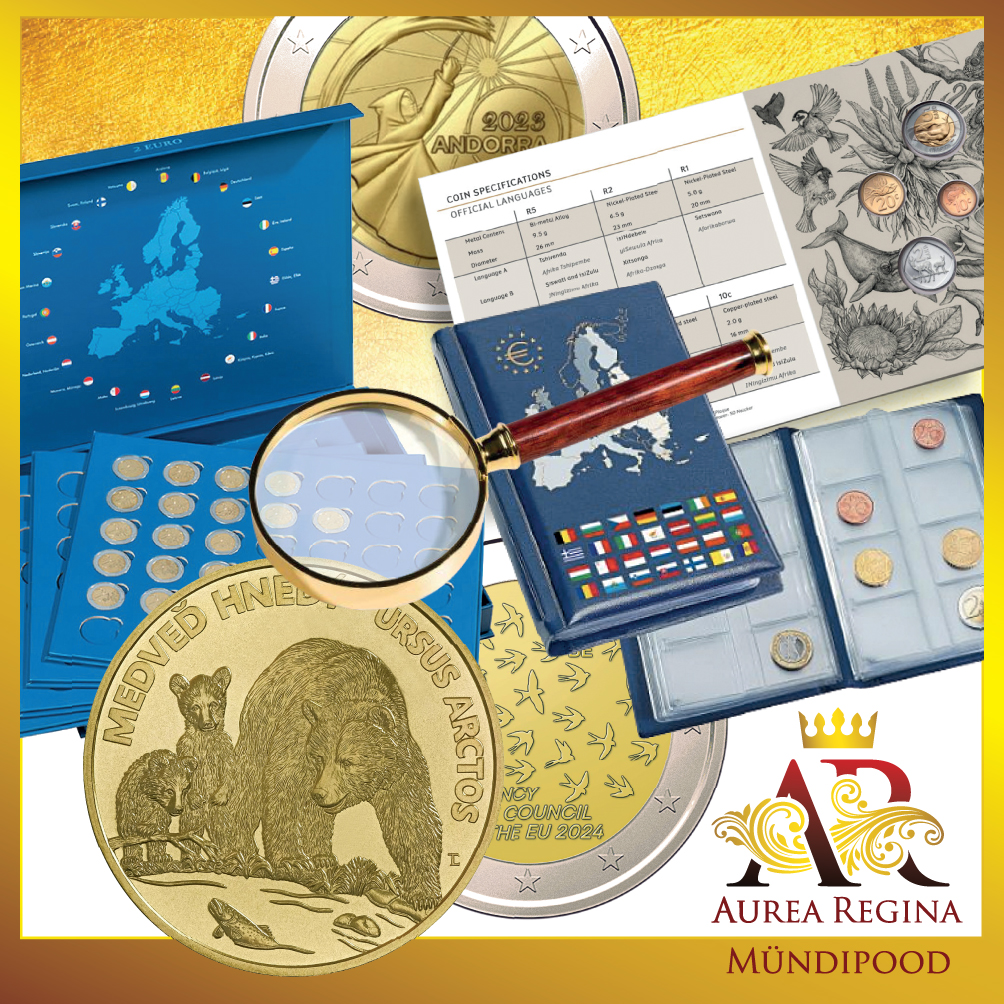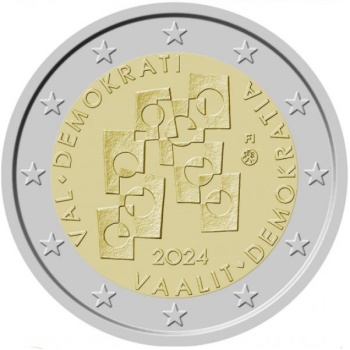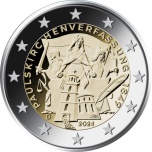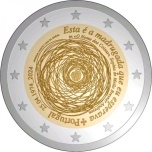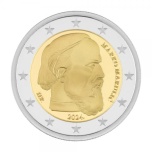Finland 2€ commemorative coin 2024 - Elections and democracy
Unit: tk
Price:
10,00 €
Feature: Elections and democracy
Description: The design shows stylized ballots. Ballots consist of circles and rectangles. The subject is abstract, but still recognizable. There are eight ballots, and they are partially overlapped, creating smaller geometric shapes at the intersections of the overlapping tickets. The year 2024 is at the bottom. The lettering ‘FI’ is on the right-hand side slightly above the midline. The text VAALIT ♦ DEMOKRATIA rotates on the right-hand side of the money ring. The text VAL ♦ DEMOKRATI is circling the coin on the left-hand side. The coin’s outer ring bears the 12 stars of the European flag.
Issuing volume: 400 000 coins
Description: The design shows stylized ballots. Ballots consist of circles and rectangles. The subject is abstract, but still recognizable. There are eight ballots, and they are partially overlapped, creating smaller geometric shapes at the intersections of the overlapping tickets. The year 2024 is at the bottom. The lettering ‘FI’ is on the right-hand side slightly above the midline. The text VAALIT ♦ DEMOKRATIA rotates on the right-hand side of the money ring. The text VAL ♦ DEMOKRATI is circling the coin on the left-hand side. The coin’s outer ring bears the 12 stars of the European flag.
Issuing volume: 400 000 coins
Similar products
Feature: Mecklenburg-Vorpommern
Description: The coin is dedicated to the German state (Land) of Mecklenburg-Western Pomerania. It is the second issuance in the second series of German 2-euro commemorative coins featuring the German states, or Länder. Each year, a coin pays tribute to one of the 16 Länder by depicting a significant building or landmark. The order of the states is based on the rotating presidency of the Bundesrat, which is one of the five permanent constitutional bodies of the Federal Republic of Germany and represents the interests of the Länder. The design shows the Königsstuhl, an iconic formation of chalk cliffs and beech forest located in Jasmund National Park on the island of Rügen. The cliffs are depicted from the perspective of the shoreline, thereby highlighting the monumentality of this unique natural landmark in a particularly effective manner. The beautifully detailed image provides scale through the combined rendering of sea, birdlife and humankind. The modern typography, in harmony with the flying seagull, is skilfully integrated into the relief. The upper half of the coin’s inner circle features the inscription ‘MECKLENBURG VORPOMMERN’, the year of issue ‘2024’, Germany’s issuing country code ‘D’ and, at the upper right, the letter ‘X’ as placeholder for the mint mark of the respective mint (‘A’, ‘D’, ‘F’, ‘G’ or ‘J’). The initials of the artist Michael Otto (from Rodenbach, Germany) are shown in the lower half of the inner circle. The coin’s outer ring bears the 12 stars of the European flag.
Issuing volume: 30 000 000 coins
Description: The coin is dedicated to the German state (Land) of Mecklenburg-Western Pomerania. It is the second issuance in the second series of German 2-euro commemorative coins featuring the German states, or Länder. Each year, a coin pays tribute to one of the 16 Länder by depicting a significant building or landmark. The order of the states is based on the rotating presidency of the Bundesrat, which is one of the five permanent constitutional bodies of the Federal Republic of Germany and represents the interests of the Länder. The design shows the Königsstuhl, an iconic formation of chalk cliffs and beech forest located in Jasmund National Park on the island of Rügen. The cliffs are depicted from the perspective of the shoreline, thereby highlighting the monumentality of this unique natural landmark in a particularly effective manner. The beautifully detailed image provides scale through the combined rendering of sea, birdlife and humankind. The modern typography, in harmony with the flying seagull, is skilfully integrated into the relief. The upper half of the coin’s inner circle features the inscription ‘MECKLENBURG VORPOMMERN’, the year of issue ‘2024’, Germany’s issuing country code ‘D’ and, at the upper right, the letter ‘X’ as placeholder for the mint mark of the respective mint (‘A’, ‘D’, ‘F’, ‘G’ or ‘J’). The initials of the artist Michael Otto (from Rodenbach, Germany) are shown in the lower half of the inner circle. The coin’s outer ring bears the 12 stars of the European flag.
Issuing volume: 30 000 000 coins
7,00 €
Feature: The 175th anniversary of the Frankfurt Constitution (also known as the St Paul’s Church Constitution, which was the first attempt to create a unified German nation state.)
Description: The design features several thematic layers. In the foreground is a perspective depiction of St Paul’s Church with the representatives of the national constitutional assembly filing in. This overlays a rendering of the constitutional document and a quill, representing the outcome of the Frankfurt Parliament. Finally, the design is crowned by three female allegories – Unity, Justice and Freedom – and the tricolour flag of black, red and gold. The vibrant three- dimensional relief evokes the timelessness of the basic democratic principles that were put down in writing for the first time and in a foundational way in the Frankfurt Constitution. The coin’s inner ring also features the inscription ‘PAULSKIRCHENVERFASSUNG 1849’ (‘St Paul’s Church Constitution 1849’) and, at the bottom, the year of issue ‘2024’, Germany’s issuing country code ‘D’, the mint mark of the respective mint (‘A’, ‘D’, ‘F’, ‘G’ or ‘J’), and the initials of the artist, Bodo Broschat from Berlin. The coin’s outer ring bears the 12 stars of the European flag.
Issuing volume: 30 000 000 coins
Description: The design features several thematic layers. In the foreground is a perspective depiction of St Paul’s Church with the representatives of the national constitutional assembly filing in. This overlays a rendering of the constitutional document and a quill, representing the outcome of the Frankfurt Parliament. Finally, the design is crowned by three female allegories – Unity, Justice and Freedom – and the tricolour flag of black, red and gold. The vibrant three- dimensional relief evokes the timelessness of the basic democratic principles that were put down in writing for the first time and in a foundational way in the Frankfurt Constitution. The coin’s inner ring also features the inscription ‘PAULSKIRCHENVERFASSUNG 1849’ (‘St Paul’s Church Constitution 1849’) and, at the bottom, the year of issue ‘2024’, Germany’s issuing country code ‘D’, the mint mark of the respective mint (‘A’, ‘D’, ‘F’, ‘G’ or ‘J’), and the initials of the artist, Bodo Broschat from Berlin. The coin’s outer ring bears the 12 stars of the European flag.
Issuing volume: 30 000 000 coins
7,00 €
Feature: The 50th anniversary of the 25th of April 1974
Description: The 25th of April 1974 is the date of the revolution that marked the establishment of the democratic rule in Portugal and the beginning of a journey of profound economic, social and cultural transformations that led to the Europeanization of the country. At the centre of the design, a carnation symbolizes the revolution, surrounded by multiple eccentric circles that suggest that people’s actions and beliefs may change over the years, but remain essentially true to the principles of the revolution. On the edge, on the right, the verse ‘Esta é a madrugada que eu esperava’ [This is the dawn I have been waiting for], and the name of its author, poet ‘Sophia de Mello Breyner Andresen’; and on the left by the national coat of arms, the captions ‘Portugal’ and ‘25 April 1974_2024’, followed by the name of the designer and the mintmark ‘Casa da Moeda’, the name of the Portuguese Mint. The coin’s outer ring bears the 12 stars of the European flag.
Issuing volume: 515 000 coins
Description: The 25th of April 1974 is the date of the revolution that marked the establishment of the democratic rule in Portugal and the beginning of a journey of profound economic, social and cultural transformations that led to the Europeanization of the country. At the centre of the design, a carnation symbolizes the revolution, surrounded by multiple eccentric circles that suggest that people’s actions and beliefs may change over the years, but remain essentially true to the principles of the revolution. On the edge, on the right, the verse ‘Esta é a madrugada que eu esperava’ [This is the dawn I have been waiting for], and the name of its author, poet ‘Sophia de Mello Breyner Andresen’; and on the left by the national coat of arms, the captions ‘Portugal’ and ‘25 April 1974_2024’, followed by the name of the designer and the mintmark ‘Casa da Moeda’, the name of the Portuguese Mint. The coin’s outer ring bears the 12 stars of the European flag.
Issuing volume: 515 000 coins
7,00 €
Feature: The 500th anniversary of Marko Marulić’s enduring legacy
Description: In recognition of this significant milestone, the Government of the Republic of Croatia has proclaimed 2024 as the Year of Marko Marulić. The central motif of the national side of the coin is the portrait of Marko Marulić (1450-1524), Croatian writer. Marko Marulić (Marul) was born in Split in 1450 and is a prominent representative of European Christian humanism and Renaissance epics. His literary works, mostly written in Latin, are comprised of works in verse and prose, his literary models being the Bible, the Church Fathers' philosophy and classical antiquity. He wrote the epic poem Judita, his magnum opus, in Croatian. It is the first artistic epic in Croatian literature composed in the Croatian language to contain the underlying poetics of Virgil and the Biblical epics. In it, Marulić achieved a true Renaissance synthesis of Croatian, Latin and Italian literary tradition, thus creating a masterpiece. Completed in 1501, it was first published twenty years later. The coin also features the inscriptions of the two-letter issuing country code "HR" (Croatia), the year of issuance "2024." and the words "MARKO MARULIĆ", which are all inscribed circularly along the edge of the coin's core. The coin’s outer ring bears the 12 stars of the European flag.
Issuing volume: 200 000 coins
Description: In recognition of this significant milestone, the Government of the Republic of Croatia has proclaimed 2024 as the Year of Marko Marulić. The central motif of the national side of the coin is the portrait of Marko Marulić (1450-1524), Croatian writer. Marko Marulić (Marul) was born in Split in 1450 and is a prominent representative of European Christian humanism and Renaissance epics. His literary works, mostly written in Latin, are comprised of works in verse and prose, his literary models being the Bible, the Church Fathers' philosophy and classical antiquity. He wrote the epic poem Judita, his magnum opus, in Croatian. It is the first artistic epic in Croatian literature composed in the Croatian language to contain the underlying poetics of Virgil and the Biblical epics. In it, Marulić achieved a true Renaissance synthesis of Croatian, Latin and Italian literary tradition, thus creating a masterpiece. Completed in 1501, it was first published twenty years later. The coin also features the inscriptions of the two-letter issuing country code "HR" (Croatia), the year of issuance "2024." and the words "MARKO MARULIĆ", which are all inscribed circularly along the edge of the coin's core. The coin’s outer ring bears the 12 stars of the European flag.
Issuing volume: 200 000 coins
17,00 €
Feature: 100 years of skiing in Andorra
Description: It is considered that the first contacts of the Andorran population with skiing took place in 1924. Nowadays, skiing is the country's king of sports making Andorra a very popular destination thanks to its snow-capped mountains, spectacular landscapes and world-class ski resorts. The design of the coin commemorates the centenary of the practice of this sport in Andorra and reproduces the lower part of the silhouette of a skier together with the name of the issuing country ‘ANDORRA’ and the year of issue ‘2024’. The coin’s outer ring bears the 12 stars of the European flag.
Issuing volume: 60 000 coins
Description: It is considered that the first contacts of the Andorran population with skiing took place in 1924. Nowadays, skiing is the country's king of sports making Andorra a very popular destination thanks to its snow-capped mountains, spectacular landscapes and world-class ski resorts. The design of the coin commemorates the centenary of the practice of this sport in Andorra and reproduces the lower part of the silhouette of a skier together with the name of the issuing country ‘ANDORRA’ and the year of issue ‘2024’. The coin’s outer ring bears the 12 stars of the European flag.
Issuing volume: 60 000 coins
35,00 €


